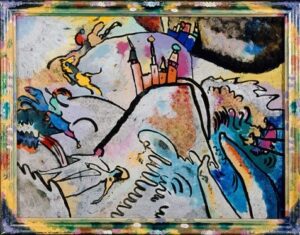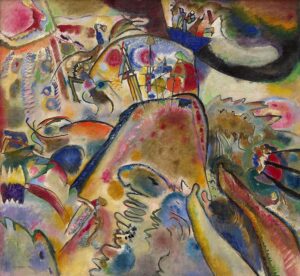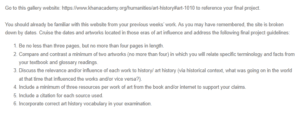Vasily Kandinsky’s Art in History
During the era of Expressionism, artists used their art to express their opinions. Accordingly, Expressionism is an artistic style that artists use to illustrate an image in their reality and express their opinions and inner feelings. Accordingly, the period of expressivity began at the beginning of the twentieth century, and various artists used their art as a form of expression. An excellent example is Vasily Kandinsky, who created his art as a form of expression. His art expressed his evolving opinion of art, and his thoughts on art were illustrated in his paintings. Accordingly, Vasily Kandinsky’s art is chosen for this paper, and they include; With Sun (1910) and Small Pleasures (1913); these art pieces are different in various aspects.

Figure 1: Vasily Kandinsky, With Sun, 1910, glass painting (Cramer and Grant, 2021)

Figure 2: Vasily Kandinsky, Small Pleasures, 1913, oil on canvas (Cramer and Grant, 2021)
The first distinguishing factor is the technique of painting. The first art piece, With Sun of 1910, was a glass painting. A glass painting is a “painting in which painted images are applied to the back surface of a clear glass pane” (Schilling, 1986). His glass painting was experimented with as he visited Germany. Additionally, it portrayed religious imagery that was also significant in his religious origin in Russia. Accordingly, glass paintings allowed him to maintain this religious and spiritual connection to his homeland. In contrast, the Small Pleasures art piece of 1913 was an oil on canvas painting. An oil painting is a painting in which a mixture of pigments is created using various oils, such as linseed oil and turpentine, to create a thin or thick consistency. The oils dry as the artist continues painting. In Figure 2, the consistency is evident from the various colors used by the artist. Accordingly, the technique used portrays something that an artist desires to relay to his customers.
The second distinguishing factor is the difference in the elements of the painting. These elements of paintings include line, color, texture, and composition. A line in a painting is created through continuous marking on a surface (Martin and Jacobus, 2018). Accordingly, in Figure 1, the painting technique involves drawing, highlighting, and glazing, finally followed by the pigments. In contrast, in Figure 2, the painting technique involves starting with the pigments followed by the details, highlights, and glazing (Schilling, 1986). Additionally, the inverted U in the paintings illustrates a hill, indicating the importance of lines in outlining the paintings. Figure 2 illustrates the use of organic lines, while Figure 1 illustrates the use of lines with various thicknesses to outline and contour various areas of the art.
The other difference is in the colors used in the paintings. Color is differentiated based on three aspects: hue, saturation, and value; accordingly, hue is the primary color used, such as red. The intensity of the hue creates saturation, and value refers to how dark or bright the hue is (Martin and Jacobus, 2018). Accordingly, the art can be differentiated based on the colors. In Figure 1, the clarity of the painting is created through the colors used. Accordingly, the primary colors used, such as blue, dominate the painting, with an intensity that promotes clarity, and the painting’s value is bright. In contrast, figure 2 depicts the contrast between the primary colors and the secondary colors used. This is evident since this is an oil painting that allows for painting over other primary colors to create secondary colors; furthermore, this painting’s value is primarily dark. Accordingly, these factors influence the painting.
The other difference is in the composition of the paintings. Accordingly, composition involves the order of details in the paintings. For example, in Figure 1, there is an inverted U with homesteads on top; men on horses and men on a boat move away from the hill (Cramer and Grant, 2021). From the painting, it is evident that the people are fleeing from something. All this information is created through balance, gradation, movement, proportion, unity, and variety. In contrast, figure 2 is an abstract painting whereby the meaning of the painting is hidden in the composition (Cramer and Grant, 2021). Subsequently, while the composition in Figure 1 creates clarity, it hides the meaning and clarity in Figure 2.
Accordingly, from these differences, we can tell the changing times in the world at the time. Subsequently, while the clarity in Figure 1 allows people to understand its message, the message is hidden in Figure 2. Vasily Kandinsky created most of his pieces when he lived in Munich Germany. Consequently, figure 1 was created during a period of spiritualism or folk art when glass paintings were preferred. Furthermore, the period of spiritualism began in the 1900s (Expressionism, a German intuition, 1905-1920, 1980). On the other hand, figure 2 was created during the period of Expressionism, which began around 1912, when artists used theatre, art, and music to display their expressivity (Expressionism, a German intuition, 1905-1920, 1980). Subsequently, the expressivity of Figure 2 is used to illustrate how the meaning of something can be hidden beneath other things. Accordingly, Vasily Kandinsky in Figure 2 drives the viewers to remove other external layers to get to the main layer hidden deep within. Therefore, the piece of art is a form of Expressionism.
In conclusion, the two art pieces are different in many ways because the state of the world influenced their creation at the time. Subsequently, the glass painting was created during a period of spiritualism, while the oil painting was created during the period of Expressionism. Therefore, all the differences in painting techniques and elements of painting used vary due to the period associated with history.
References
- Expressionism, a German intuition, 1905-1920. New York: Solomon R. Guggenheim Foundation.
Cramer, D. and Grant, D., 2021. Khan Academy; Kandinsky, Apocalypse, Abstraction. [online] Khanacademy.org. Available at: <https://www.khanacademy.org/humanities/art-1010/early-abstraction/expressionism1/a/kandinsky-apocalypse-abstraction?modal=1>
Martin, F. and Jacobus, L., 2018. HUMANITIES THROUGH THE ARTS. 10th ed. MCGRAW-HILL.
Schilling, E., 1986. [online] Mountainscholar.org. Available at: <https://mountainscholar.org/bitstream/handle/10217/179357/STUF_1001_Schilling_Eugene_Vasily.pdf?sequence=1>
ORDER A PLAGIARISM-FREE PAPER HERE
We’ll write everything from scratch
Question 

Vasily Kandinsky’s Art in History
Go to this gallery website: https://www.khanacademy.org/humanities/art-history#art-1010 to reference your final project.
You should already be familiar with this website from your previous weeks’ work. As you may have remembered, the site is broken down by dates. Cruise the dates and artworks located in those eras of art influence and address the following final project guidelines:
- Be no less than three pages, but no more than four pages in length.
- Compare and contrast a minimum of two artworks (no more than four) in which you will relate specific terminology and facts from your textbook and glossary readings.
- Discuss the relevance and/or influence of each work to history/ art history (via historical context, what was going on in the world at that time that influenced the works and/or vice versa?).
- Include a minimum of three resources per work of art from the book and/or internet to support your claims.
- Include a citation for each source used.
- Incorporate correct art history vocabulary in your examination.